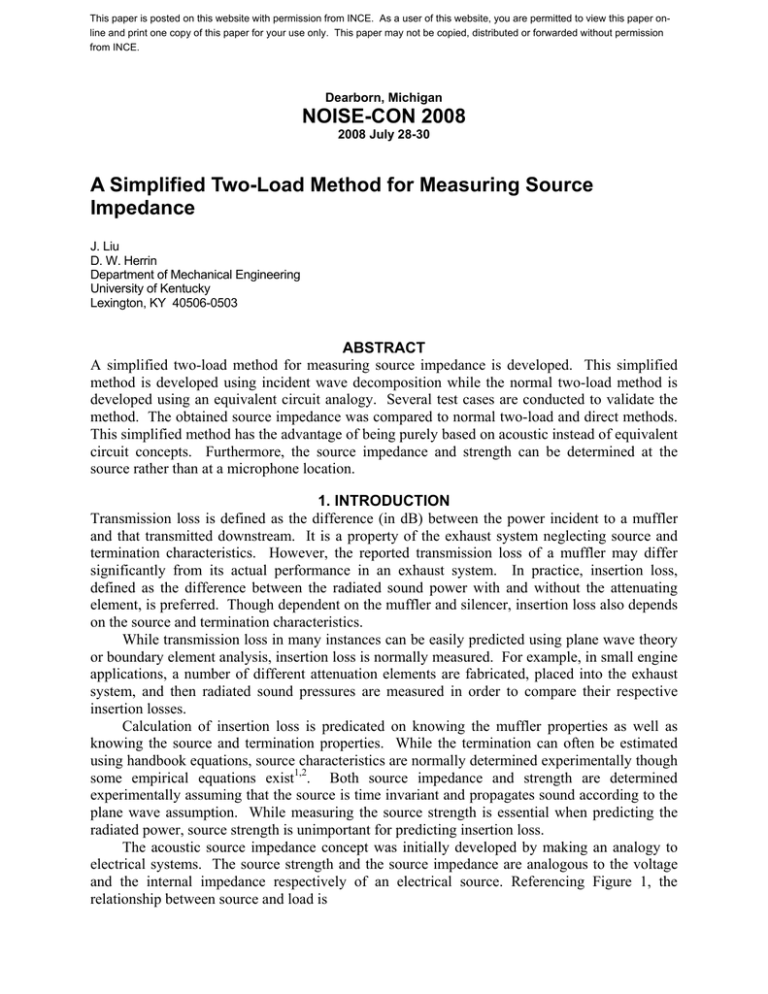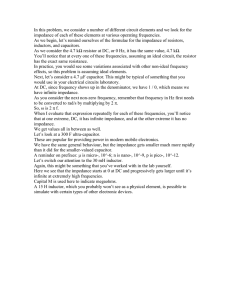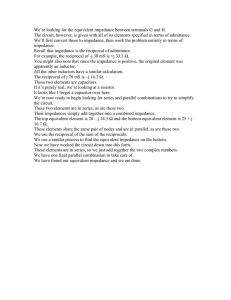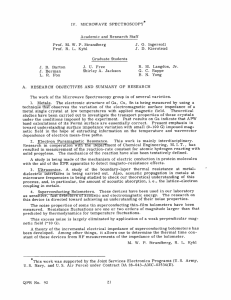Document 13665791
advertisement

This paper is posted on this website with permission from INCE. As a user of this website, you are permitted to view this paper online and print one copy of this paper for your use only. This paper may not be copied, distributed or forwarded without permission from INCE. Dearborn, Michigan NOISE-CON 2008 2008 July 28-30 A Simplified Two-Load Method for Measuring Source Impedance J. Liu D. W. Herrin Department of Mechanical Engineering University of Kentucky Lexington, KY 40506-0503 ABSTRACT A simplified two-load method for measuring source impedance is developed. This simplified method is developed using incident wave decomposition while the normal two-load method is developed using an equivalent circuit analogy. Several test cases are conducted to validate the method. The obtained source impedance was compared to normal two-load and direct methods. This simplified method has the advantage of being purely based on acoustic instead of equivalent circuit concepts. Furthermore, the source impedance and strength can be determined at the source rather than at a microphone location. 1. INTRODUCTION Transmission loss is defined as the difference (in dB) between the power incident to a muffler and that transmitted downstream. It is a property of the exhaust system neglecting source and termination characteristics. However, the reported transmission loss of a muffler may differ significantly from its actual performance in an exhaust system. In practice, insertion loss, defined as the difference between the radiated sound power with and without the attenuating element, is preferred. Though dependent on the muffler and silencer, insertion loss also depends on the source and termination characteristics. While transmission loss in many instances can be easily predicted using plane wave theory or boundary element analysis, insertion loss is normally measured. For example, in small engine applications, a number of different attenuation elements are fabricated, placed into the exhaust system, and then radiated sound pressures are measured in order to compare their respective insertion losses. Calculation of insertion loss is predicated on knowing the muffler properties as well as knowing the source and termination properties. While the termination can often be estimated using handbook equations, source characteristics are normally determined experimentally though some empirical equations exist1,2. Both source impedance and strength are determined experimentally assuming that the source is time invariant and propagates sound according to the plane wave assumption. While measuring the source strength is essential when predicting the radiated power, source strength is unimportant for predicting insertion loss. The acoustic source impedance concept was initially developed by making an analogy to electrical systems. The source strength and the source impedance are analogous to the voltage and the internal impedance respectively of an electrical source. Referencing Figure 1, the relationship between source and load is ps p = L zs + zL z L (1) where ps and zs are the source strength and source impedance respectively; pL and zL are the load sound pressure and load impedance respectively. zs pL ps zL Figure 1: Equivalent circuit analogy for acoustic source impedance. While useful, this analogy is not an ideal representation of the acoustic system. First of all, the source strength (ps) has no acoustic meaning except for ideal sources. In addition, sound pressure using the electric analogy can not be decomposed into incident or reflected sound waves.3 Figure 2 illustrates source impedance from a practical standpoint. The sound waves generated by the source propagate along the duct. While a portion of the energy propagates through the attenuating element, some of the energy is reflected by the attenuating element back towards the source. The reflected sound waves though partially absorbed by the source also reflect back from the source. The amount of sound energy reflected or absorbed by the source is a function of the source impedance. Waves Leaving Source Attenuating Element (i.e. Load) Acoustic Source Reflected from Source Reflected from Attenuating Element Figure 2: Schematic illustrating the behavior of a realistic source. 2. THEORETICAL DEVELOPMENT Instead of using the equivalent circuit analogy, the source impedance can be obtained using wave decomposition. Boden and Abom4 related this wave decomposition concept in a manner similar to the following discussion. However, they did not apply the concept to the measurement of source impedance via the 2-load method. As illustrated in Figure 3, the major premise is that the incident sound wave (A) consists of two parts. a. The outgoing wave from the source (Ps+). b. The reflected wave by the source boundary (B⋅RS). Thus, A can be expressed as A = Ps + + B ⋅ Rs (2) The incident wave A and the reflected wave B can be obtained from the measured sound pressure at two locations (P1,P2) via wave decomposition. 5 P1 Load Source Ps+ B ⋅ Rs P2 A B x=0 Figure 3: Schematic illustrating the wave decomposition premise. By applying two different acoustic loads and measuring the sound pressures (P1,P2), two different sets of A’s and B’s are determined. Then, two unknowns Ps+ and Rs can be solved using Rs = A1 − A2 B1 − B2 (3) and Ps+ = B1 A2 − B2 A1 . B1 − B2 (4) If multiple loads are applied, then a least squares algorithm can be utilized to achieve smoother and more accurate results.6 The source impedance can be obtained from the reflection coefficient Rs and expressed as Zs = 1 + Rs ( B1 − B2 ) + ( A1 − A2 ) = . 1 − Rs ( B1 − B2 ) − ( A1 − A2 ) (5) 3. RELATION TO TWO-LOAD METHOD If the equivalent circuit analogy is compared to the wave decomposition approach, a relationship between Ps+ and Ps can be developed. Figure 4 places the equivalent circuit analogy side by side with the wave decomposition approach. Notice that the load pressure (pL) and load impedance can be expressed in terms of the incident and reflected waves as pL = A + B (6) and ZL = pL B + A = u0 B − A respectively. Substituting Equations (5), (6) and (7) into Equation (1) yields: ps B+ A = ⎛ 1 + Rs B + A ⎞ ⎛ B + A ⎞ + ⎟ ⎜ ⎟ ⎜ ⎝ 1 − Rs B − A ⎠ ⎝ B − A ⎠ Which can be simplified to (7) (9) ⎛ 1 − Rs ⎞ A = Ps ⋅ ⎜ ⎟ + B ⋅ Rs . ⎝ 2 ⎠ (10) Comparing equation (10) to equation (2), it is evident that the source impedance (Zs) obtained by the 2-load and simplified 2-load methods are identical. However, the source impedance will differ between the two approaches because of dissimilar data processing approaches. The 2-load method requires the load impedances to be known and a load pressure for each condition. In contrast, the simplified procedure does not require the load impedance to be known, but does require two load pressures to be measured for each condition. Source Zs , p s Load ZL, pL L1 A B x=0 Figure 4: Schematic comparing wave decomposition and circuit analogy. However, the source strength Ps and outgoing source strength Ps+ are different and can be related to each other via the equation4 ⎛ 1 − Rs ⎞ Ps + = Ps ⋅ ⎜ ⎟. ⎝ 2 ⎠ (11) Note that Ps+ is outgoing source strength and it can be physically defined as the sound pressure PL (or outgoing wave A) at the source-load separation position when there is no reflection B as illustrated by Figure 5. Source Zs , Ps Ps+ ρ 0c Figure 5: Schematic comparing source strength and outgoing source strength 4. EXPERIMENTAL RESULTS A simple experiment was conducted to investigate the utility of the simplified two-load method. The source impedance of a loudspeaker was measured using the direct method, 2-load method, and simplified 2-load method. The loudspeaker is rated for use above 500 Hz. Thus, the low frequency cut-off is 500 Hz. For the two indirect methods, three different loads were employed (open end, closed end, and closed end with absorbing material). Then a least squares algorithm is used to smooth the result. Figure 6 shows a photograph of the measurement setup. Source (loudspeaker) Load Figure 6: photograph showing measurement setup Normalized source impedance (Real) . Figures 7 and 8 compare respectively the real and imaginary parts of the source impedance. Notice the excellent agreement between the approaches. However, it is notable that the simplified 2-load method results exhibit less noise. Figure 9 compares the outgoing source strength between the two indirect methods. Again, the source strength acquired using the simplified approach has less noise. 10 Direct 2-load Simplified 2-load 5 0 0 500 1000 1500 2000 2500 3000 3500 4000 Frequency (Hz) Normalized Source Impedance (Imag.) . Figure 7: Real part of the Source Impedances Comparison 5 Direct 2-load Simplified 2-load 0 -5 0 500 1000 1500 2000 2500 3000 3500 Frequency (Hz) Figure 8: Imaginary part of the Source Impedances Comparison 4000 Outgoing Source Strength (dB) 110 2-load Simplified 2-load 105 100 0 500 1000 1500 2000 2500 3000 3500 4000 Frequency (Hz) Figure 9: Outgoing Source Strengths comparison 5. CONCLUSION AND DISCUSSION A simplified 2-load method has been developed and compared with the existing 2-load approach. It has been demonstrated that the simplified method uses the reflection of the primary source energy as an external source. In that sense, it is similar to the direct method. The primary source itself can be used as the reference signal. This may be advantageous since the source itself can be used to obtain the desired data without the necessity of adding a 20 dB higher external source (typically required for the direct method).7 We believe this similarity to the direct method may also explain why the simplified 2-load method produces smoother results than the existing 2-load approach. ACKNOWLEDGEMENTS We are grateful for the support of the Vibro-Acoustics Consortium. REFERENCES 1 M.L.Munjal, “Flow-acoustic measurements,” Chap. 5 in Acoustics of ducts and mufflers, by M.L.Munjal (Wiley, New York, 1987). 2 M.L.Munjal and A.G.Doige, “On uniqueness, transfer and combination of acoustic sources in one-dimensional systems,” Journal of sound and vibration, 121(1), 25-35 (1988). 3 Davies P.O.A.L, “Transmission matrix representation of exhaust system acoustic characeristics”, Journal of sound and vibration, 151(2), 333-338 (1991). 4 Hans Boden and Mats Abom, “Modelling of Fluid Machines as Sources of Sound in Duct and Pipe Systems”, Acta Acoustica 3(1995) 549-560. 5 ASTM, “ASTM Standard E1050-98, Standard Test Method for Impedance and Absorption of Acoustical Material Using a Tube, Two Microphones and a Digital Frequency Analysis System”. Philadelphia: American Society for Testing and Materials (1998). 6 L. Desmons and J. Hardy, “A Least Squares Method for Evaluation of Characteristics of Acoustical Sources,” Journal of Sound and Vibration, 175(3), 365-376 (1994). 7 David F. Ross and Malcolm J. Crocker, “Measurement of the Acoustic Internal Source Impedance of an Internal Combustion Engine”, Journal of Acoustical Society of America, 74(1), (1983).





